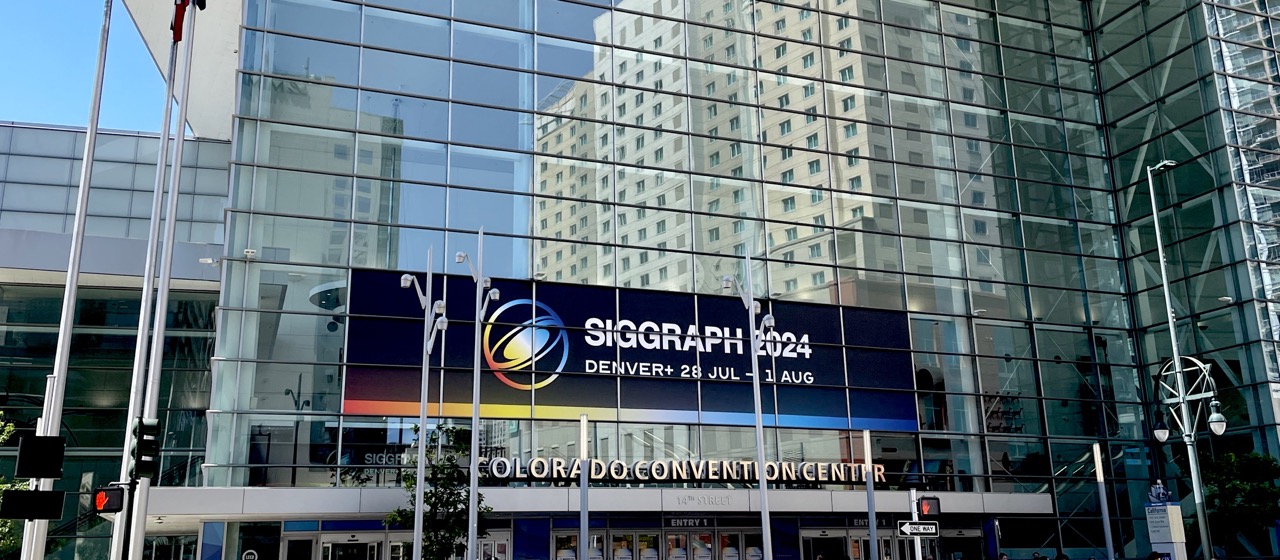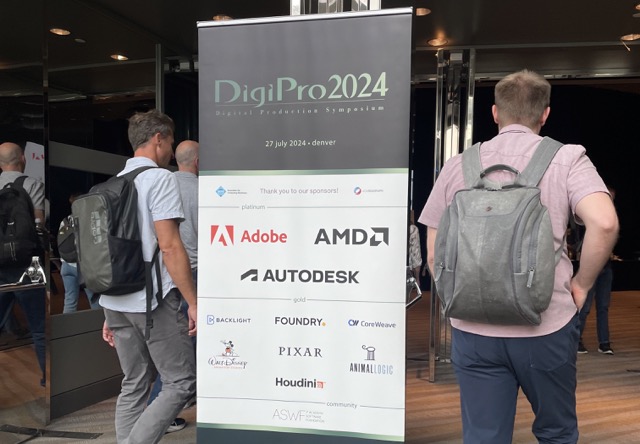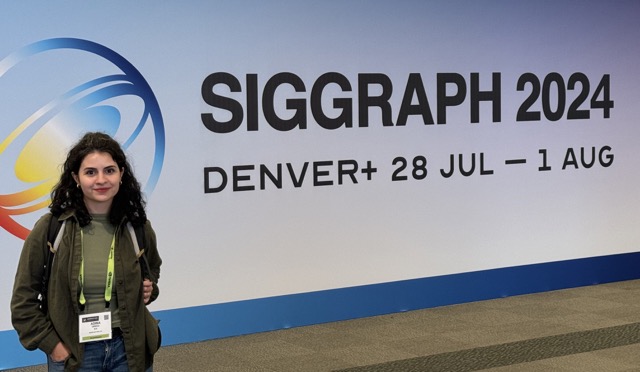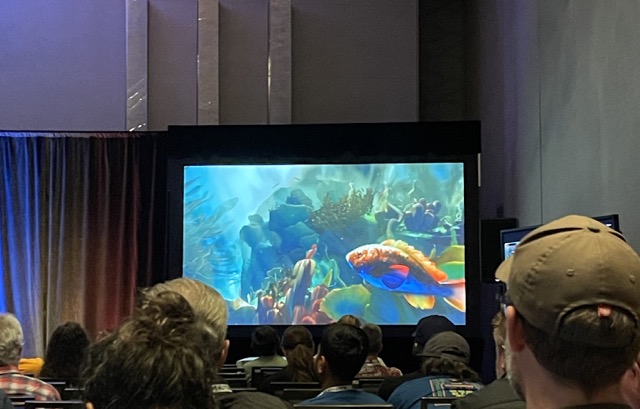SIGGRAPH 2024, DigiPro and Open Source Days – how was it?
I was fortunate enough to find myself (for the first time!) at SIGGRAPH, DigiPro and Open Source Days (by Academy Software Foundation) this past weekend in Denver, Colorado. It was a wildly exciting trip so I thought I would share some of my takeaways from these last few days of talks, panels, papers and networking, from a more artistic perspective.

These three conferences/symposiums were held in very close proximity to each other (time and location), so I was able to dip in and out of sessions throughout the days. Of course, each one has a slightly different target audience and definitely different topics. Nonetheless, I think that even if you may not be the most technical person (as I myself am not yet), you can find something interesting to attend and learn about. I'll detail below a few highlights and key takeaways from the things I attended – summarising these experiences serves as a great way to digest all of the information I've been steadily absorbing (and was it a lot of information)
DigiPro

The only snapshot I managed to take at some point during a break, most of the day was quite busy with back-to-back presentations and lots of socialising in between.
I'm doing these chronologically, so I'll start with DigiPro - perhaps one of the most technical days of all, but also incredibly insightful. I don't think I would recommend this symposium to someone with no technical knowledge at all because it may become very boring very quickly, However, for anyone interested in how tooling is made, how studio pipelines work or how different technological advancements may affect your work as an artist, I think there is plenty to take away. If not, at least there's a lot of wonderful work and innovation to marvel at.
The highlight of this year's session was of course LAIKA's keynote, which gave a mind-boggling, highly detailed look at their behind-the-scenes: everything from ideation, to prop-making, to how they manage to combine practical effects and VFX in a manner which doesn't take away from the joy of either. LAIKA's work has been a favourite of mine for a long time (yes I have seen and loved Coraline). While I was well aware of how complex stop-motion animation is, I found myself in complete awe: it's hard to imagine the type of creative and technical issues you might encounter at that level. If anything, it was awfully inspiring to see how such beautiful things come to life – with a lot of hard work that makes it look like magic.
Second highlight, from an artistic perspective, was Francesco Siddi's presentation on Creating tools for stylised design workflows in Blender. For more technical info, you can find the paper here. Blender has been around for a long time now, and there's no denying that its adoption in the industry is somewhat inevitable at this point - not because anybody said so, but because people want it and artists do use it. I have more to say about that later since there was a presentation at Open Source Days exactly about this topic. Blender 4.2 looks as best as it could, and the new things that will be released later this year look incredible.
There were a lot of great tools put forward by Animal Logic, all of which were quite artist-focused and beautifully done. My impression after listening to everyone speak about the ups and downs of developing for/maintaining a pipeline is that there is so much work going on behind the scenes that artists don't usually see. All of this work is there to ensure that everything goes smoothly and that people have whatever creative tools they need at their disposal in order to express themselves. This is, you know, a small reminder to show appreciation to the peeps building the tools. Kudos to all of them!
SIGGRAPH

A very tired me at SIGGRAPH, in a bit of shameless self promotion combined with genuine excitement.
There's so much to see and do at SIGGRAPH. Compared to DigiPro and Open Source Days, SIGGRAPH has a much wider array of exhibits in different formats, spanning games, VFX, and technology in general. I went to a few talks, including a really insightful session for students/juniors in the industry. The advice was much more tailored to the current needs and expectations of companies, with specific tips for resume and portfolio presentation. It's always nice to hear from the people who actually do the hiring, as opposed to the mindless chatter of random people on LinkedIn – chatter which generally lacks both context and impact.
The conference is quite focused on technical papers, but has a wide array of immersive technologies and art gallery exhibits. The whole program is on this years website, so if you would like to see the kinds of exhibits they displayed or maybe you missed something, I suggest checking that out. As always, it's great to see bits of artistic expression out in the open, most of which were also nicely executed.
My experience of SIGGRAPH was made great by the diversity of programs and the general feeling of the conference. It's inspiring to see small and big companies come together in a pretty impressive display of works. Most of all, it is inspiring to see the sheer number of people interested in computer graphics as a whole, be it games, media, television or film. I'm writing this article now still charged with the enthusiasm of the place.
Open Source Days (by Academy Software Foundation)

Small snippet from Open Source Days during the Blender presentation
Open Source Days, hosted and organised by Academy Software Foundation (ASF) was an entirely different ordeal, first of all because in the spirit of access to everyone, the conference was free to attend. It's of course much more of a niche in terms of topics, but still with lots of useful technical and non-technical presentations. Open source software is used by all companies to some degree, so it's safe to say that most companies have some sort of interest in the direction (and wellbeing) of these efforts (or so one would hope – as I found out, even some of the biggest OSS projects with widespread industry adoption suffer from lack of consistent contributions).
I will not get into many technical aspects of the conference, but a few things stuck out to me from the presentations I attended.
1. Contributions to open-source are quite low.
One would expect that software used by a large number of people from big companies would have plenty of contributions from the community, right? Wrong.
Few companies allocate time for their employees to consistently contribute to open-source software. There are many possible reasons for that, but it made me think about what open source software I use and if there's any way in which I could possibly contribute.
2. Blender will eventually get adopted in the industry.
And by that I mean formally. From my understanding, Blender's GPL license is the main problem when trying to integrate it into a pipeline (from the adopting company's perspective). In my next point I'll talk about some data from another presentation, but the main takeaway from that is: people are already using Blender, whether to do pre-vis, modelling, prototyping or something of the sorts. Artists use it because it's free and open source, it's easy to learn and has lots of resources/good documentation AND can be used for everything if one really wishes, sort of eliminating the need to shift back and forth. I'm not saying it's a jack of all trades and master of all, but close. Even when working with multiple programs, Blender makes it easy to export and import works relatively easy.
3. Pipelines are very interesting entities.
How does this tie in with the previous point? Well, there was a presentation about the state of pipelines (technically a Birds of a Feather session from SIGGRAPH) which showed the results of a pretty widespread survey made by Ynput. Very intriguing results, also related to the use of open source software. You can get the full survey results somewhere on their website, but the gist is that people seem to be using Blender whether they tell their bosses or not.
Conclusions
I would consider this my first "official" contact with the industry, most definitely the first official events of the sorts that I've had the pleasure to attend. The people I've met and talks I've attended left me a positive impression of the community, which is most encouraging.
Some people I've spoken with were quite surprised, if a bit skeptical, about my intention to join the industry as an artist. The thing is a lot of people, even in technical positions now, started as artists. And without artists, there would be no workflow to improve, no pipeline would be needed, no pixels would be produced. It's a symbiotic relationship between the creative and technical aspects of producing such work that makes it so interesting and impactful.
Also, contributions are important – we are once again reminded that everyone benefits when each person pipes in with whatever they can. OSS is like the potluck of the software community (and not only), so I do think it'd be nice if we could all put our tiny efforts in.
Hopefully, there will be more SIGGRAPHS, DigiPros and Open Source Days for me in sight.
'Till next time!